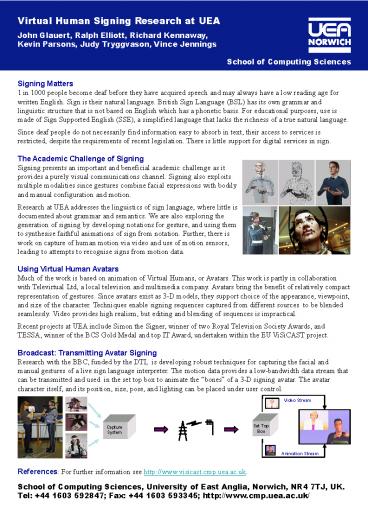Signing Matters - PowerPoint PPT Presentation
1 / 2
Title:
Signing Matters
Description:
British Sign Language (BSL) has its own grammar and linguistic ... Rest of Today Largely dry, cloudy and fairly dull, but brightening up from northwest. ... – PowerPoint PPT presentation
Number of Views:69
Avg rating:3.0/5.0
Title: Signing Matters
1
Virtual Human Signing Research at UEA John
Glauert, Ralph Elliott, Richard Kennaway,Kevin
Parsons, Judy Tryggvason, Vince Jennings
School of Computing Sciences
Signing Matters 1 in 1000 people become deaf
before they have acquired speech and may always
have a low reading age for written English. Sign
is their natural language. British Sign Language
(BSL) has its own grammar and linguistic
structure that is not based on English which has
a phonetic basis. For educational purposes, use
is made of Sign Supported English (SSE), a
simplified language that lacks the richness of a
true natural language. Since deaf people do not
necessarily find information easy to absorb in
text, their access to services is restricted,
despite the requirements of recent legislation.
There is little support for digital services in
sign. The Academic Challenge of Signing Signing
presents an important and beneficial academic
challenge as it provides a purely visual
communications channel. Signing also exploits
multiple modalities since gestures combine
facial expressions with bodily and manual
configuration and motion. Research at UEA
addresses the linguistics of sign language, where
little is documented about grammar and
semantics. We are also exploring the generation
of signing by developing notations for gesture,
and using them to synthesise faithful animations
of sign from notation. Further, there is work on
capture of human motion via video and use of
motion sensors, leading to attempts to recognise
signs from motion data. Using Virtual Human
Avatars Much of the work is based on animation of
Virtual Humans, or Avatars. This work is partly
in collaboration with Televirtual Ltd, a local
television and multimedia company. Avatars bring
the benefit of relatively compact representation
of gestures. Since avatars exist as 3-D models,
they support choice of the appearance, viewpoint,
and size of the character. Techniques enable
signing sequences captured from different sources
to be blended seamlessly. Video provides high
realism, but editing and blending of sequences is
impractical. Recent projects at UEA include
Simon the Signer, winner of two Royal Television
Society Awards, and TESSA, winner of the BCS Gold
Medal and top IT Award, undertaken within the EU
ViSiCAST project. Broadcast Transmitting Avatar
Signing Research with the BBC, funded by the DTI,
is developing robust techniques for capturing
the facial and manual gestures of a live sign
language interpreter. The motion data provides a
low-bandwidth data stream that can be transmitted
and used in the set top box to animate the
bones of a 3-D signing avatar. The avatar
character itself, and its position, size, pose,
and lighting can be placed under user
control. References For further
information see http//www.visicast.cmp.uea.ac.uk.
School of Computing Sciences, University of East
Anglia, Norwich, NR4 7TJ, UK. Tel 44 1603
592847 Fax 44 1603 593345 http//www.cmp.uea.a
c.uk/
2
Applications of Virtual Human Signing John
Glauert, Ralph Elliott, Richard Kennaway,Kevin
Parsons, Judy Tryggvason, Vince Jennings
School of Computing Sciences
Signing Research at UEA ViSiCAST Virtual
Signing, Capture, Animation, and Storage was an
EU Framework V project involving ITC, RNID,
Televirtual Ltd, IvD (NL), University of Hamburg
(DE), IRT (DE), INT (FR). The project developed
practical systems for delivering virtual human
signing over the internet. An example is the
weather forecast system presented below. eSIGN
Signing on eGovernment Websites is an EU eContent
Project involving University of Hamburg (DE),
RNID, Viataal (NL), Norfolk County Council,
Televirtual Ltd, Systematics (DE). Building on
ViSiCAST, eSIGN is extending applications to
eGovernment websites in three countries. New
content creation techniques are being developed.
Web Services Weather Forecasts Although the
weather forecast varies hour by hour, summary
forecasts follow a predictable pattern. The
domain can be fully described for a number of
natural spoken languages and natural sign
languages. A tool has been developed which
allows a non-signer to build forecasts using
standard weather phrases. These are then
converted into text and sign for a number of
languages. Our implementation covers English,
BSL, Dutch, SLN (Sign Language of the
Netherlands), and DGS (German Sign Language). A
web plugin for Internet Explorer enables
forecasts to be presented using sign sequences by
seamless blending of captured phrases A live
service is available in the Netherlands at
http//www.dovenschap.org/demo.html and a service
is planned in the UK hosted by the RNID.
Signing Content on eGovernment Websites
To enhance the usefulness of the internet for
sign language users, especially for dealing with
complex interactions, signed commentary will be
provided for eGovernment forms. Help information
in sign language will accompany information
hosted by Norfolk County Council (uk), Viataal
(NL), and Hamburg (DE). Content creation will be
integrated with standard content management so
that traditional multilingual support includes
signing with only minimal change to web services
logic. The eSIGN project focuses on content
created by synthesis from notation, rather than
motion capture. As a result, information can
easily be updated without the need for an
expensive capture session. Information of an
ephemeral nature can be generated automatically
and interactively. References For further
information see http//www.visicast.cmp.uea.ac.uk.
School of Computing Sciences, University of East
Anglia, Norwich, NR4 7TJ, UK. Tel 44 1603
592847 Fax 44 1603 593345 http//www.cmp.uea.a
c.uk/































